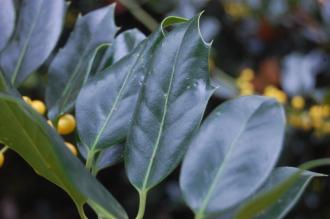
Ilex aquifolium ‘Bacciflava’ (08/11/2015, Kew Gardens, London)
Position: Full sun to partial shade
Flowering period: Late spring
Soil: Moist, well drained
Eventual Height: 8m
Eventual Spread: 4m
Hardiness: 6a, 6b, 7a, 7b, 8a, 8b, 9a, 9b, 10a, 10b
Family: Aquifoliaceae
Ilex aquifolium ‘Bacciflava’ is an evergreen large shrub or small tree with a pyramidal habit. Its glossy dark green leaves are ovate with spiny margins, up to 6cm long and 4cm broad and variable in shape. As the tree matures the new leaves have a tendency to not have spines and are entire. Its bark is gray and smooth. This variety is a female form of Ilex and will not produce male pollen, a male Ilex aquifolium or variety will need to be in close proximity in order for this plant to produce berries. Its fruit are yellow berries and these persist through the winter months.

Ilex aquifolium ‘Bacciflava’ Fruit (08/11/2015, Kew Gardens, London)
The species Ilex aquifolium, commonly known as European Holly, English Holly or just Holly, is native to western and southern Europe (including the UK), northwest Africa and southwest Asia. Ilex aquifolium ‘Bacciflava’ is commonly known as Yellow Fruited Holly.
The etymological root of the binomial name Ilex is derived from the old Latin name for the Holly. Aquifolium is derived from the Latin acus ’needle’ and floium ’leaf’, in reference to the pointed leaves.
The landscape architect may find Ilex aquifolium ‘Bacciflava’ useful as a specimen shrub with attractive winter fruit. It may also be grown as a formal hedge (and effective barrier) and is particularly useful for shady locations. It will tolerate maritime conditions and atmospheric pollution.

Ilex aquifolium ‘Bacciflava’ Leaf (08/11/2015, Kew Gardens, London)
Ecologically, Ilex aquifolium ‘Bacciflava’ flowers are attractive to pollinating insects. The canopy of this shrub forms an effective shelter for nesting birds.
Ilex aquifolium ‘Bacciflava’ prefers moist, fertile, well-drained soils. It tolerates most pH of soil.
Ilex aquifolium ‘Bacciflava’ requires little maintenance. If maintaining as a hedge it should be cut in late autumn to early spring. If necessary it may also be cut in mid summer, but winter berries may be lost.

Landscape Architecture

